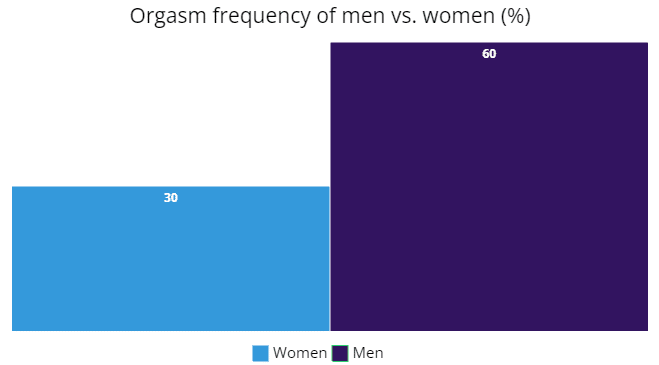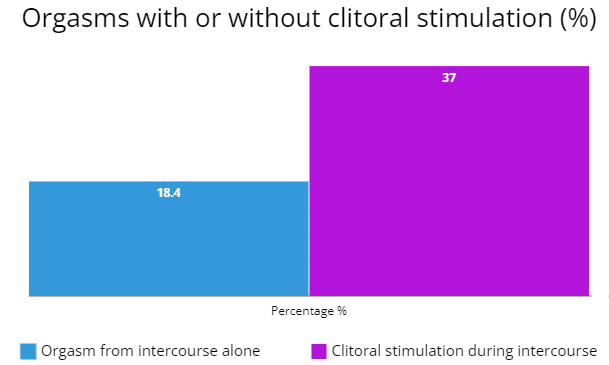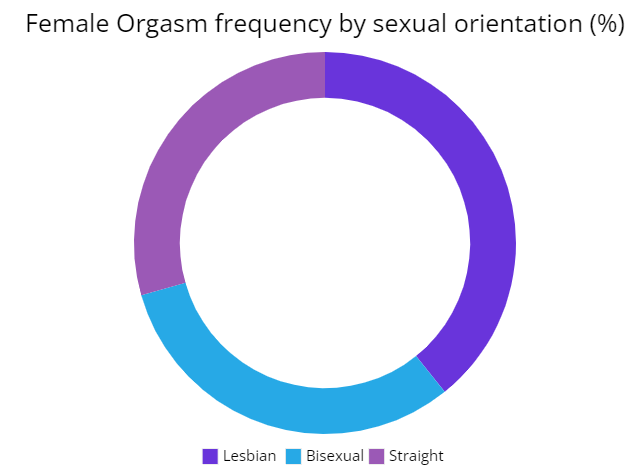For vulva owners, orgasms are indeed harder to attain during partnered play than it is for penis owners. Hello orgasm gap!
Now the thing about the orgasm gap is that people, companies, institutions, and professionals are continuously working hard to close it. Hence, why there’s a huge popularity in sex toys. But wouldn’t it be great to enjoy blissful moments of self-love and partnered play?
Now we’re not saying that sex toys shouldn’t be incorporated into your couples’ fun. But how about we move into a space where two people can merge together and experience orgasmic euphoria on an equal footing? Perhaps new data that’s recently emerged can help to close the orgasm gap! Hooray!
New Data on the Female Orgasm
First things first, what is the orgasm gap? It’s when women tend to orgasm less frequently than men. Why does it exist? For many, penetration alone rarely, if ever, leads to orgasms.
Statistics reveal that men are significantly more likely to orgasm during sex compared to women. A YouGov study found that in Britain, only three in 10 women orgasm every time they have sex, compared to three in five men who do.

This is something that everyone should learn about. It’s often clitoral stimulation (with or without penetration) that can get women to that wonderful sensation of climax.
The Role of Clitoral Stimulation
Clitoral stimulation plays a crucial role in female orgasms. A 2017 study of 1,055 adult women in the U.S. showed that only 18.4% could reach orgasm from intercourse alone, while nearly 37% could achieve it with clitoral stimulation during intercourse.

Not just that, but a woman’s orgasm also tends to be highly correlated to several psychological and societal factors such as:
- Body image
- Sexual assertiveness
- Sexual shame
- Sexual pride
- Sexual attitudes (permissiveness, birth control)
- Gender norms
- Double standards
- Prioritising male sexual pleasure
In contrast, many men experience orgasms in the realm of physiology. For example, even when erection issues occur, a man can simply pop a blue pill or use a cock ring, making them ready to play. Women don’t really have that luxury when their sexual satisfaction is rooted in psychology.
Luckily, a 2021 study looked at the sociocultural influences on orgasm frequency and sexual satisfaction in women.
The research looked at 1043 women (with the median age being 38), using a variety of factors to determine how sociocultural factors and orgasm frequency are linked to sexual satisfaction.
Their variables included:
- Masturbation leading to orgasm
- Orgasming with a familiar partner
- Orgasming with a new partner
- The frequency of multiple orgasms
Their findings were quite fascinating, with the most important key takeaways being:
An Orgasm Isn’t the Only Indication of Sexual Satisfaction
For many of the women, experiencing an orgasm that was accompanied with sex-positivity, emotional satisfaction, sexual pride, a positive body image, and sexual assertiveness tended to result in more sexual satisfaction than those who experienced an orgasm without all of the above. In other words, it’s an experience, not just an orgasm, that creates sexual satisfaction.
Sexual Assertiveness and Pride is the Biggest Indicator of Orgasm Frequency
In the study, the more comfortable a woman felt in her own body, the more sexual satisfaction she experienced. When these women were able to communicate what they wanted in the bedroom with their partner(s), it made them feel assertive and powerful, which often led to more orgasms. This was shown to be true whether she was masturbating alone, or having sex with a new or a familiar partner.
Frequency of Orgasms Are Most Correlated to Sexual Satisfaction When with a Familiar Partner
In this case, it wasn’t about quality but more so, quantity. It was shown that those who engaged in sex with a familiar partner enjoyed more frequent orgasms, which led to more sexual satisfaction. The researchers also wanted to clarify that, in this case, a “familiar partner” wasn’t necessarily someone with whom the subject was in a long-term relationship with, but could also be a friend with benefits.
Multiple Orgasms Don’t Always Predict Sexual Satisfaction
You may be thinking that multiple orgasms equal immense sexual satisfaction. This new research begs to differ. In fact, the study found that those who experienced one orgasm were just as likely to experience sexual satisfaction as those who experienced multiple orgasms.
Women Who Are More Sex-Positive are More Likely to Orgasm During One-Night-Stands and Less Likely to Orgasm with a Familiar Partner
In this study, those women who were more sex-positive and who rejected the idea that men’s sexual pleasure comes first were more likely to orgasm during a one-night-stand. It also found that these women may just prefer casual sex as opposed to sex with a familiar partner. This was especially true when the women were motivated by reasons such as desire for sexual pleasure and adventure, and when they were focused on their own pleasure.
Time to Orgasm
The time it takes to reach orgasm also varies greatly. On average, it takes men about five to seven minutes to orgasm, whereas for women, it’s about 14 minutes during partnered sex
Sexual Orientation and Orgasm Frequency
Sexual orientation influences orgasm frequency. Lesbian women are more likely to always orgasm (40%) compared to bisexual (32%) and straight women (30%). This difference highlights the need for a more nuanced understanding of female sexuality.

Multiple Orgasms and Satisfaction
Interestingly, having multiple orgasms doesn’t significantly predict sexual satisfaction. A study found that women who reported having just one orgasm during sex indicated just as much sexual satisfaction as those who had many.
Sex Without Penetration
Many women find non-penetrative sexual activities more likely to lead to orgasm. This includes actions like rubbing, grinding, and caressing externally.
Closing Thoughts
The journey to closing the orgasm gap involves recognizing the unique aspects of female sexual satisfaction. It’s about understanding that an orgasm isn’t the only measure of a fulfilling sexual experience.
Sources:
- YouGov Study on Orgasm Frequency: This study provided insights into the orgasm frequency among different genders and how it varies across sexual orientations. (Source: Yahoo Life UK Article)
- 2017 Study on Clitoral Stimulation: This research highlighted the percentage of women who can reach orgasm from intercourse alone versus with clitoral stimulation. (Source: Yahoo Life Article)
- Research on Time to Orgasm: This study offered information on the average time it takes for men and women to reach orgasm. (Source: Yahoo Life Article)
- Study on Sexual Orientation and Orgasm Frequency: This research compared orgasm frequency across different sexual orientations, particularly highlighting differences among heterosexual, bisexual, and lesbian women. (Source: Yahoo Life UK Article)
- Study on Multiple Orgasms: This study explored the relationship between multiple orgasms and sexual satisfaction. (Source: Psychology Today Article)
- Research on Non-Penetrative Sexual Activities: This source discussed the significance of non-penetrative sexual activities in leading to orgasm for women. (Source: Yahoo Life Article)

